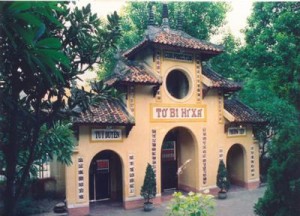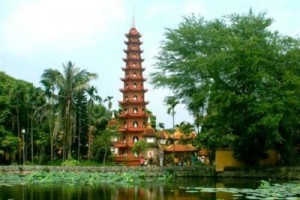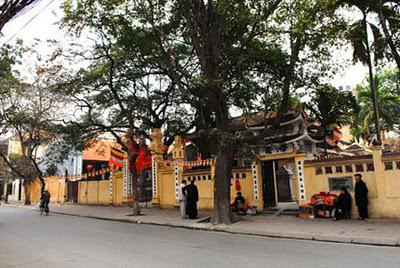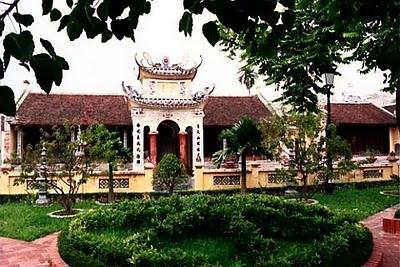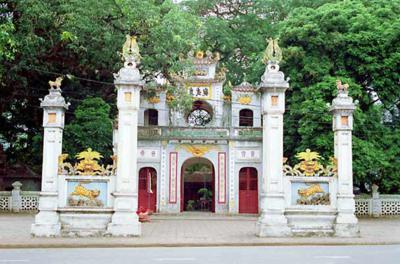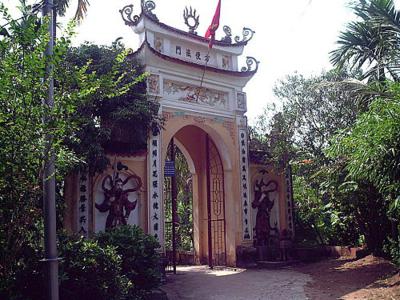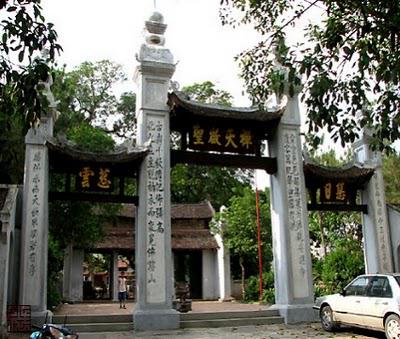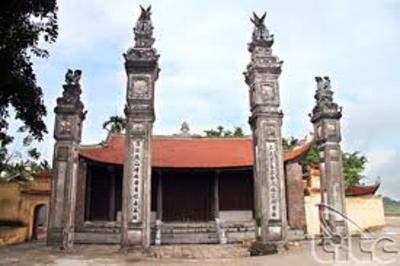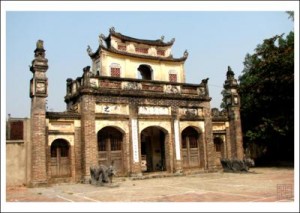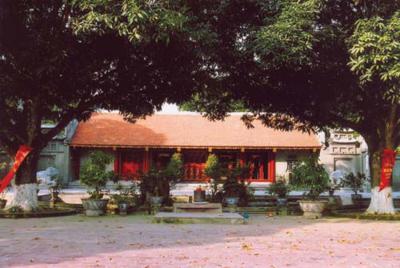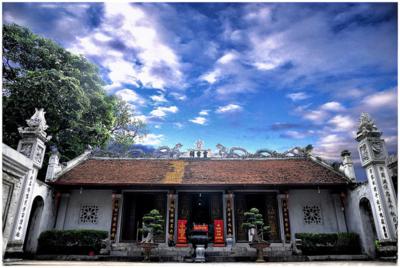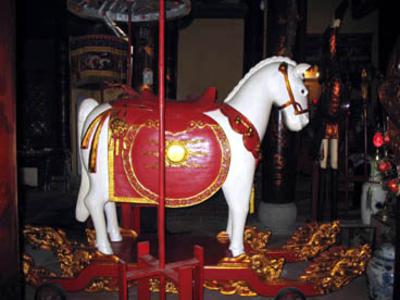Quan Su Pagoda
The Quan Su is Hanoi’s largest and most popular pagoda. It was first erected on land in An Tap village close to the southern gate of Thang Long (the old name for Hanoi).
Originally a small Buddhist pagoda located near the 15th century Quan Su house used to receive foreign envoys and ambassadors, the pagoda eventually became the headquarters of the Tonkin Buddhist Association. Over the years, the pagoda has been restored and expanded many times.
One Pillar Pagoda
Close to what is now the Ho Chi Minh Museum, the One Pillar (or One Tree) Pagoda overlooks a small pond. It was built by Emperor Ly Thai Tong after a dream in which the Goddess of Mercy handed him a male child on a lotus flower. He created the small wooden pagoda to resemble a lotus blossom to commemorate the birth of his long-awaited heir.
Unfortunately, the original was destroyed during the war with the French. The present building is a replica erected the year after the colonists were finally expelled in 1954.
Tran Quoc Pagoda
The original pagoda was built in the 6th century and is considered the oldest in Vietnam. It was founded on the bank of the Red River by King Ly Nam De who named it Khai Quoc (National Founder). Much later, it was moved to its present site beside Hanoi’s Ho Tay (West) Lake during the reign of King Le Kinh Tong (1600-1618) and renamed Tran Quoc (National Defence). The current building is the result of major renovations in 1815, but one of its effigies dates back to the early 17th century.
In the garden, there is a Pipal Tree (ficus religiosa, but known throughout history as the Bodhi tree) reputedly grown from a cutting of the original tree where Buddha sat and gained enlightenment.
Hoe Nhai Pagoda
This pagoda was founded in 1020 by a Chinese Buddhist monk named Trong Dien. The ruling monarch at that time had persecuted Buddhist monks. Dien described the Buddhist philosophy for him, and he relented.
Inside, a statue of Dien shows him sitting on the Kings back, symbolising the understanding between them. The interior framework of the building and the altars are all fashioned in hardwood and are very attractive.
Lien Phai Pagoda
This pastel coloured multi-tiered pagoda stands in a pleasant garden hidden in a labyrinth of alleys leading off Bach Mai Street just below the city centre to the south. It is set amongst pleasant and tranquil gardens next to the main building of worship. The pagoda was founded by one of the Nguyen Lords in the early 18th century who picked up a rock resembling a lotus root in his back garden. Considering this a sign from Buddha, he converted his palace into the pagoda.
A visit also provides an opportunity to venture into the maze of tiny alleys off the main roads where the majority of Hanoi’s residents live, and where foreigners are a great rarity.
Quan Thanh Pagoda
This impressive pagoda was founded during the reign of King Ly Thai To (1010-1028), and is located beside Truc Bach Lake. It is ornately decorated and stands before a pleasant courtyard shaded by banyan trees. Inside, there is an imposing four-ton bronze statue of the God of the North cast in 1677, together with his attendant spirits, a snake and a tortoise – clearly a Taoist symbol.
Tay Ho Pagoda
Named after the lake it sits beside, the pagoda occupies a superb position on a tongue of land projecting into the water. It is dedicated to Thanh Mau, the Mother Goddess, who appeared on the lake as a pretty girl, smiling and reciting poetry to a fisherman, then vanished.
It is one of Hanoi’s most popular pagodas, attracting many worshippers on the first and 15th of each lunar month. It’s also a delightful place to visit, particularly as part of a trip around the lake by boat – it has its own landing stage.
Lang Pagoda
Located in Hanoi’s suburbs, the Lang Pagoda provides an opportunity to see a semi-rural area, yet another of Hanoi’s many faces. It was built during the reign of Emperor Ly Than Tong (1128-1138). Entry is via an ancient concrete and wooden gateway flanked by stone elephants. The courtyard encloses an octagonal pavilion. For visitors, it offers a peaceful setting where local students like to read and paint, and old people enjoy relaxing in the shade of the trees.
Chem Temple
Chem Temple is in Thuy Phuong village near the southern bank of the Thang Long Bridge. The temple is dedicated to Ly Than, who was sent to assist the first emperor of the Chi’in Dynasty in China and married his daughter during the second century BC. It is believed that the Chem Temple was built around the 7th or 8th century on the site of Ly Than’s residence. The current temple today was erected in the 19th century.
The temple contains two gilded wooden statues of Ly Than and his wife sculpted in 1888. It’s a relaxing place, with excellent views of the Red River
Phu Dong Temple
Phu Dong Temple is in Gia Lam District, once the home of a tenth-century legendary hero called Thanh Giong. It is located in a peaceful rural area across the Red River to the east of Hanoi city centre. The site actually consists of two temples.
The Dong Temple is large and impressive. According to local legend, it was built by King Ly Thai immediately after the king moved to Thang Long in 1010. It now has two prayer halls, a rear palace and, unusually, a theatre built on the front pond for water puppet shows, all of which were constructed in 19th century.
The Mau Temple was originally built in 1693 on the outer dyke and is dedicated to Thanh Dong’s mother. Nearby is an old garden once owned by Thanh Dong’s mother. It contains a stele bearing a legend. Apparently, a giant trampled upon the vegetable patch and left a footprint. The next day, Dong’s mother placed her foot in the giant print, became pregnant and gave birth to Thanh Dong.
Dong Nhan Temple
Located in central Hanoi, this temple pays homage to the Trung sisters, Trung Trac and Trung Nhi, Vietnamese heroines who led a rebellion to drive out the Han invaders in AD 40.
The Dong Nhan Temple was originally built on the Red River bank in the 12th century, but the bank collapsed in 1819 and the temple was moved to its current location. A local legend tells that one night in early February, two statues were discovered floating in the Red River in 1142 and were brought ashore by villagers. King Ly Anh Tong was told and ordered a temple dedicated to the statues to be built on the spot.
The two statues stand at the rear of the temple and wear hibiscus hats with their hands rising up to their faces attended by twelve statues of female generals on each side.
Thu Le Temple (Kneeling Elephant Temple)
The temple derives its name from two kneeling elephants guarding the gate.
Located in Hanoi’s Thu Le botanical garden, this temple was built in the Ly Thai Tong Dynasty (1028-54) near West Lake, and was dedicated to Linh Lang, son of King Ly Thai Tong.
According to legend, the King’s wife was confronted by a dragon, and became pregnant. When the child was born, he had dragon scales and lights twinkling like pearls on his chest. As an adult, he led the army to expel invaders. The grateful king wanted to abdicate in his favour, but Linh Lang refused. He was transformed into a black dragon entangled around a stone slab and disappeared into West Lake. The king ordered a temple to be built on the site.
The Thu Le Temple still contains two bronze statues and a large concave stone slab. It’s in an attractive wooded landscape beside a pond, a calm and harmonious ambiance conducive to contemplation.
Bach Ma (White Horse) Temple in the Old Quarter
According to legend, in the ninth century, King Ly Thai To was struggling to build the Hanoi Citadel, but the walls kept collapsing because of the marshy sub-soil. Bach Ma (White Horse), who was the spirit of Thang Long, appeared in the guise of a builder and told the King how to create foundations that would support the masonry. The King was grateful, and ordered the building of a pagoda dedicated to Bach Ma. A statue of the horse stands beside the altar.
The current structure was built in the 18th century, and is typical of Hanoi’s pagodas. It’s hidden away in the Old Quarter, and blends in well with its bustling streets. There is even a shop built into the walls to the left of the entrance.
Source: Haivenu-vietnam

